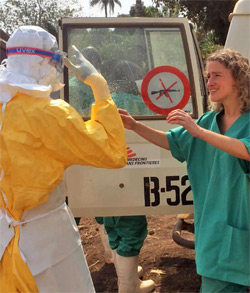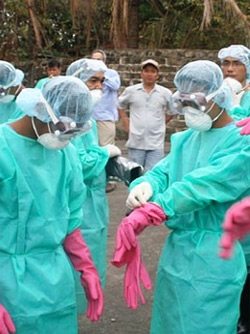|
|
Ebola: Complete Information on Sources, Symptoms, Diagnosis and Treatment

Ebola is a rare but deadly virus that causes bleeding inside and outside the
body. As the virus spreads through the body, it damages the immune system and
organs. Ultimately, it causes levels of blood-clotting cells to drop. This leads
to severe, uncontrollable bleeding.The disease, also known as Ebola hemorrhagic
fever or Ebola virus, kills up to 90% of people who are infected.
The CDC says there�s no significant risk of Ebola in the United States. It has
strong safety measures in place for people who have Ebola and are brought to the
U.S. for treatment.
Ebola can spread from country to country when people travel. So it is possible
for it to reach the U.S. if an infected person travels here. But there are ways
to prevent people from coming to U.S. airports with the disease. Airline crews
are trained to spot the symptoms of Ebola in passengers flying from places where
the virus is found. Crews are told to quarantine anyone who looks infected.
Ebola virus disease (EVD) or Ebola hemorrhagic fever (EHF) is a disease of
humans and other primates caused by an ebolavirus. Symptoms start two days to
three weeks after contracting the virus, with a fever, sore throat, muscle pain
and headaches. Typically, vomiting, diarrhea and rash follow, along with
decreased functioning of the liver and kidneys. Around this time, affected
people may begin to bleed both within the body and externally.
The virus may be acquired upon contact with blood or bodily fluids of an
infected animal. Spreading through the air has not been documented in the
natural environment. Fruit bats are believed to carry and spread the virus
without being affected. Once human infection occurs, the disease may spread
between people, as well. Male survivors may be able to transmit the disease via
semen for nearly two months. To make the diagnosis, typically other diseases
with similar symptoms such as malaria, cholera and other viral hemorrhagic
fevers are first excluded. To confirm the diagnosis, blood samples are tested
for viral antibodies, viral RNA, or the virus itself.
Prevention includes decreasing the spread of disease from infected animals to
humans. This may be done by checking such animals for infection and killing and
properly disposing of the bodies if the disease is discovered. Properly cooking
meat and wearing protective clothing when handling meat may also be helpful, as
are wearing protective clothing and washing hands when around a person with the
disease. Samples of bodily fluids and tissues from people with the disease
should be handled with special caution.
No specific treatment for the disease is yet available. Efforts to help those
who are infected are supportive and include giving either oral rehydration
therapy (slightly sweet and salty water to drink) or intravenous fluids. The
disease has a high mortality rate, often killing between 50% and 90% of those
infected with the virus. EVD was first identified in Sudan and the Democratic
Republic of the Congo.
The disease typically occurs in outbreaks in tropical regions of sub-Saharan
Africa. From 1976 (when it was first identified) through 2013, fewer than 1,000
people per year have been infected. The largest outbreak to date is the ongoing
2014 West Africa Ebola outbreak, which is affecting Guinea, Sierra Leone,
Liberia and Nigeria. As of mid August 2014, 2,127 suspected cases resulting in
the deaths of 1,145 have been reported. Efforts are going on to develop a
vaccine; however, none yet exists.
How Do You Get Ebola
Ebola isn't as contagious as more common viruses like colds, influenza, or
measles. It spreads to people by contact with the skin or bodily fluids of an
infected animal, like a monkey, chimp, or fruit bat. Then it moves from person
to person the same way. Those who care for a sick person or bury someone who has
died from the disease often get it.
Other ways to get Ebola include touching contaminated needles or surfaces. You
can�t get Ebola from air, water, or food. A person who has Ebola but has no
symptoms can�t spread the disease, either.
Symptoms of Ebola
 Early on, Ebola can feel like the flu or other illnesses. Symptoms show up 2
to 21 days after infection and usually include: Early on, Ebola can feel like the flu or other illnesses. Symptoms show up 2
to 21 days after infection and usually include:
-
High fever
-
Headache
-
Joint and muscle aches
-
Sore throat
-
Weakness
-
Stomach pain
-
Lack of appetite
As the disease gets worse, it causes bleeding inside the body, as well as
from the eyes, ears, and nose. Some people will vomit or cough up blood, have
bloody diarrhea, and get a rash.
Signs and symptoms of Ebola usually begin suddenly with am influenza-like stage
characterized by fatigue, fever, headaches, joint, muscle and abdominal pain.
Vomiting, diarrhea and loss of appetite are also common. Less common symptoms
include: sore throat, chest pain, hiccups, shortness of breath and trouble
swallowing. The average time between contracting the infection and the start of
symptoms is 8 to 10 days, but it can vary between 2 and 21 days. Skin
manifestations may include a maculopapular rash (in about 50% of cases). Early
symptoms of EVD may be similar to those of malaria, dengue fever or other
tropical fevers, before the disease progresses to the bleeding phase.
In 40�50% of cases, bleeding from puncture sites and mucous membranes (e.g.
gastrointestinal tract, nose, vagina and gums) has been reported. In the
bleeding phase, which typically starts 5 to 7 days after first symptoms internal
and subcutaneous bleeding may present itself through reddening of the eyes and
bloody vomit. Bleeding into the skin may create petechiae, purpura, ecchymoses
and hematomas (especially around needle injection sites).
Types of bleeding known to occur with Ebola virus disease include vomiting
blood, coughing it up or blood in the stool. Heavy bleeding is rare and is
usually confined to the gastrointestinal tract. In general, the development of
bleeding symptoms often indicates a worse prognosis and this blood loss can
result in death. All people infected show some symptoms of circulatory system
involvement, including impaired blood clotting. If the infected person does not
recover, death due to multiple organ dysfunction syndrome occurs within 7 to 16
days (usually between days 8 and 9) after first symptoms
Ebola Diagnosis
 Sometimes it's hard to tell if a person has Ebola from the symptoms alone.
Doctors may test to rule out other diseases like cholera or malaria. Tests of
blood and tissues also can diagnose Ebola. If you have Ebola, you�ll be isolated
from the public immediately to prevent the spread. Sometimes it's hard to tell if a person has Ebola from the symptoms alone.
Doctors may test to rule out other diseases like cholera or malaria. Tests of
blood and tissues also can diagnose Ebola. If you have Ebola, you�ll be isolated
from the public immediately to prevent the spread.
The medical history, especially travel and work history along with exposure to
wildlife are important to suspect the diagnosis of EVD. The diagnosis is
confirmed by isolating the virus, detecting its RNA or proteins, or detecting
antibodies against the virus in a person's blood. Isolating the virus by cell
culture, detecting the viral RNA by polymerase chain reaction (PCR) and
detecting proteins by enzyme-linked immunosorbent assay (ELISA) is effective
early and in those who have died from the disease. Detecting antibodies against
the virus is effective late in the disease and in those who recover.
During an outbreak, virus isolation is often not feasible. The most common
diagnostic methods are therefore real time PCR and ELISA detection of proteins,
which can be performed in field or mobile hospitals. Filovirions can be seen and
identified in cell culture by electron microscopy due to their unique
filamentous shapes, but electron microscopy cannot tell the difference between
the various filoviruses despite there being some length differences.
Treatment of Ebola
No ebolavirus-specific treatment exists. Treatment is primarily supportive
in nature and includes minimizing invasive procedures, balancing fluids and
electrolytes to counter dehydration, administration of anticoagulants early in
infection to prevent or control disseminated intravascular coagulation,
administration of procoagulants late in infection to control bleeding,
maintaining oxygen levels, pain management, and the use of medications to treat
bacterial or fungal secondary infections. Early treatment may increase the
chance of survival. A number of experimental treatments are being studied.
In the United States, the FDA's animal efficacy rule can be used in combination
with a phase I clinical trial to demonstrate reasonable safety for an
experimental, unapproved drug, to obtain permission to treat people who are
infected with Ebola with the drug under the Expanded access program. The Animal
Efficacy Rule exists, because the normal path for testing the safety and
efficacy of drugs is not possible for diseases caused by dangerous pathogens or
toxins. The FDA allowed two drugs, ZMapp and an RNA interference drug called "TKM-Ebola",
to be used in people infected with Ebola under these programs during the 2014
outbreak.
The unavailability of experimental treatments in the most affected regions
during the 2014 outbreak spurred controversy, with some calling for experimental
drugs to be made more widely available in Africa on a humanitarian basis, and
others warning that making unproven experimental drugs widely available would be
unethical, especially in light of past experimentation conducted in developing
countries by Western drug companies.
As a result of the controversy, the World Health Organization convened an expert
meeting of bioethicists on 11 August 2014 to consider the implications of making
the experimental treatment more widely available. The panel reached consensus
that the circumstances warrant the use of unproven interventions with as yet
unknown efficacy and adverse effects both for treatment and for prevention, and
also said that deciding which treatments should be used and how to distribute
them equitably were matters that needed further discussion.
Use of untested experimental drugs
On 2014-07-31, an experimental drug, ZMapp, was first tested on humans. It was
administered to two Americans who had been infected with Ebola. Both people
appeared to have had positive results. Soon thereafter ZMapp was administered to
a third Ebola patient, a 75 year old priest, who nonetheless died. On 12 August
the WHO released an advisory statement regarding the ongoing Ebola outbreak,
recommending specifically for the more widespread use of the compassionate use
exemption for experimental drugs, in efforts to contain the ongoing Ebola
outbreak, with the aim of more quickly halting and eliminating the current Ebola
outbreak.
Other treatments
Other promising treatments rely on antisense technology. Both small interfering
RNAs (siRNAs) and phosphorodiamidate morpholino oligomers (PMOs) targeting the
Zaire Ebola virus (ZEBOV) RNA polymerase L protein could prevent disease in
nonhuman primates. TKM-Ebola is a small-interfering RNA compound, currently
tested in a phase I clinical trial in people.
Videos
Dated 18 August 14
|
|
|
|
|









